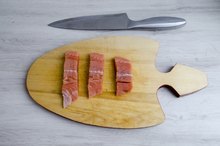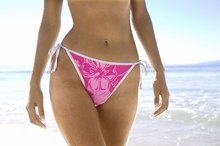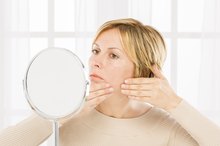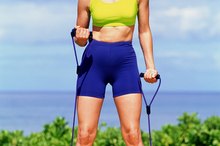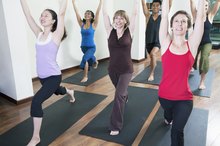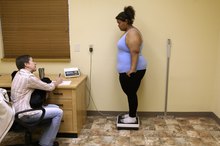How to Use a Wooden Massager on Cellulite
Cellulite appears as dimpled skin on thighs, hips and buttocks and tends to haunt women more than men. According to PhillyTrib.com, cellulite is fat pushing through a network of fibrous strands. As fat accumulates, it pushes upwards toward the skin surface. The connective tissue that forms this support network between the skin and muscle pulls downwards towards your bones causing small bumps of fat to appear on the surface of the body. Cellulite is difficult to get rid of and many products, such as wooden massagers, promise to smooth out the uneven surface. Science has not proven these items to be effective against cellulite. However, vigorous massage with a roller implement is one treatment that may improve the look of cellulite on a short-term basis.
Warm up your muscles through exercise. Cellulite forms as a result of body fat 2. Exercise will not only help keep off the fat, but will promote circulation to warm the muscles. Wooden massage tool manufacturer Hydrea London points out that a hand massager will also help to reduce lactic acid build up in muscle tissue after exercise to prevent cramping 4. However, they offer no clinical studies that prove this claim. As an alternative, a hot shower will stimulate circulation and loosen the muscles.
How to Get Rid of Cellulite on the Legs Fast
Learn More
Apply a cellulite cream to the area prior to massaging it. The use of these creams may help to increase blood flow to the area and improve the massage. Follow the directions provided with the product for proper application.
Lay the massager down on the dimpled area with the rollers touching your skin. Massage the affected site with the wooden implement, moving in a large circular pattern. For example, massage your thighs by placing the rollers on your skin and drawing orange-sized circles over the cellulite. Press hard enough to stimulate, but not hard enough to cause pain. Work the area for as long as it feels comfortable. There is no established time for the massage. Once one area feels fatigued, move on to the next affected site.
Tips
Place your body in a comfortable position that allows you easy access to sites with heavy cellulite. For instance, if working your thighs, sit in a comfortable chair for the massage. If possible, have a partner give the treatment. It may be difficult for you to reach some areas on your own. Use a massager with a long handle if you are working alone. This will help you reach problems areas effectively.
Warnings
Extensive bruising on skin may be a sign you are massaging too vigorously. Let the area heal and the bruising fade before trying the massage again.
Related Articles
References
- Oprah.com: The Cure for Cellulite? Seriously?
- Metro UK: 10 Top Facts About Cellulite
- Doctor Oz: Best Cellulite Cures
- Look Fantastic: Hydrea London Ebony Wood Massager
- Philly Trib: Complete Lifestyle Change Required to Fight Cellulite
- Plastic Surgery Choices: Endermologie Greensboro
- Dover, J. S., Orringer, J. S., Alam, M. (2014). Body Shaping, Skin Fat and Cellulite E-Book: Procedures in Cosmetic Dermatology Series. United Kingdom: Elsevier Health Sciences.
- Tokarska K, Tokarski S, Woźniacka A, Sysa-Jędrzejowska A, Bogaczewicz J. Cellulite: a cosmetic or systemic issue? Contemporary views on the etiopathogenesis of cellulite. Postepy Dermatol Alergol. 2018;35(5):442-446. doi:10.5114/ada.2018.77235
- Luebberding S, Krueger N, Sadick NS. Cellulite: An evidence-based review. Am J Clin Dermatol. 2015;16(4):243-256. doi:10.1007/s40257-015-0129-5
- American Academy of Dermatology Association. Cellulite treatments: What really works?.
- U.S. Food & Drug Administration. ZELTIQ CoolSculpting System 510(k). Published September 24, 2015.
- Zerini I, Sisti A, Cuomo R, et al. Cellulite treatment: A comprehensive literature review. J Cosmet Dermatol. 2015;14(3):224-40. doi:10.1111/jocd.12154
Writer Bio
Writing since 1999, Darla Ferrara is an award-winning author who specializes in health, diet, fitness and computer technology. She has been published in "Mezzo Magazine" and Diet Spotlight, as well as various online magazines. Ferrara studied biology and emergency medical technology at the University of Nebraska and Southeast Community College.

